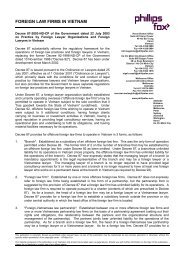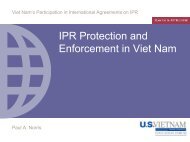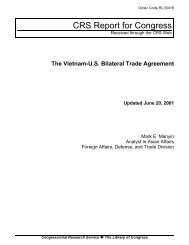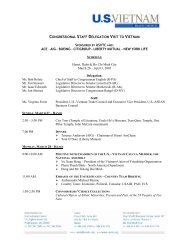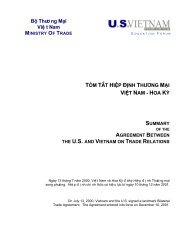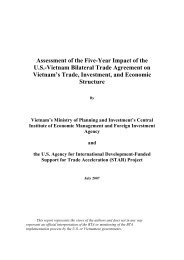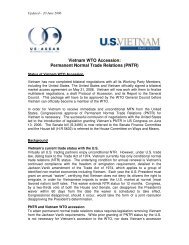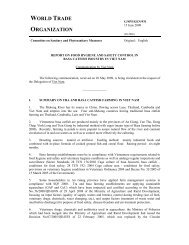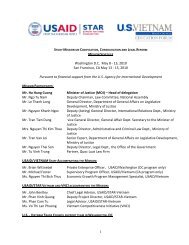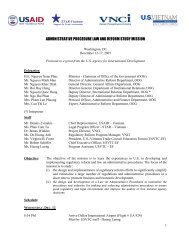Climate risks and adaptation in Asian coastal megacities: A synthesis
Climate risks and adaptation in Asian coastal megacities: A synthesis
Climate risks and adaptation in Asian coastal megacities: A synthesis
- No tags were found...
Create successful ePaper yourself
Turn your PDF publications into a flip-book with our unique Google optimized e-Paper software.
a 30 percent <strong>in</strong>crease <strong>in</strong> the flood-prone area. InManila, even if current flood <strong>in</strong>frastructure plansare implemented, the area flooded <strong>in</strong> 2050 will <strong>in</strong>creaseby 42 percent <strong>in</strong> the event of a 1-<strong>in</strong>-100-yearflood under the high emission scenario comparedto a situation without climate change. In HCMC,the area <strong>in</strong>undated <strong>in</strong>creases (from 54 percent <strong>in</strong>a situation without climate change to 61 percent<strong>in</strong> 2050 with climate <strong>risks</strong> considered) for regularevents <strong>and</strong> for extreme (1-<strong>in</strong>-30 year) events from68 percent (without climate change) to 71 percent(with climate <strong>risks</strong> considered) <strong>in</strong> 2050 under thehigh emission scenario. Further, there is a significant<strong>in</strong>crease <strong>in</strong> both depth <strong>and</strong> duration for both regular<strong>and</strong> extreme floods over current levels <strong>in</strong> 2050. Theanalysis also highlights areas that will be at greaterrisk of flood<strong>in</strong>g <strong>in</strong> each metropolitan area. In MetroManila, for <strong>in</strong>stance, areas of high population densitysuch as Manila City, Quezon City, Pasig City,Marik<strong>in</strong>a City, <strong>and</strong> San Juan M<strong>and</strong>aluyong City arelikely to face serious <strong>risks</strong> of flood<strong>in</strong>g.Increase <strong>in</strong> population exposed to flood<strong>in</strong>gdue to climate changeIn all three cities, there is likely to be an <strong>in</strong>crease <strong>in</strong>the number of persons exposed to flood<strong>in</strong>g <strong>in</strong> 2050under different climate scenarios compared to asituation without climate change. For <strong>in</strong>stance, <strong>in</strong>Bangkok, <strong>in</strong> 2050, the number of persons affected(flooded for more than 30 days) by a 1-<strong>in</strong>-30-yearevent will rise sharply for both the low <strong>and</strong> highemission scenarios by 47 percent <strong>and</strong> 75 percentrespectively compared to those affected by floods <strong>in</strong>a situation without climate change. In Manila, for a1-<strong>in</strong>-100-year flood <strong>in</strong> 2050, under the high emissionscenario more than 2.5 million people are likely tobe affected assum<strong>in</strong>g that the <strong>in</strong>frastructure <strong>in</strong> 2050is the same as <strong>in</strong> the base year, <strong>and</strong> about 1.3 millionpeople if the 1990 master plan is implemented. InHCMC, currently, about 26 percent of the populationwould be affected by a 1-<strong>in</strong>-30-year event. However,by 2050, it is estimated that approximately 62 percentof the population will be affected under the highemission scenario without implementation of theproposed flood control measures. Even with theimplementation of these flood control measures,more than half of the projected 2050 population isstill likely to be at risk from flood<strong>in</strong>g dur<strong>in</strong>g extremeevents. How to plan for such large percentages ofpopulation be<strong>in</strong>g exposed to future flood<strong>in</strong>g needsto be seriously considered.Costs of damage likely to be substantial<strong>in</strong> <strong>and</strong> can range from 2 to 6 percentof regional GDPIn Bangkok, the <strong>in</strong>creased costs associated withclimate change (<strong>in</strong> an A1FI scenario) from a 1-<strong>in</strong>-30-year flood is THB 49 billion ($1.5 billion) orapproximately 2 percent of GRDP. These are the additionalcosts associated with climate change. Theactual costs of a 1-<strong>in</strong>-30-year flood would <strong>in</strong>cludecosts result<strong>in</strong>g from l<strong>and</strong> subsidence <strong>and</strong> would beeven higher. In Manila, a similar 1-<strong>in</strong>-30-year floodcan lead to costs of flood<strong>in</strong>g rang<strong>in</strong>g from PHP 40billion ($0.9 billion) given current flood control<strong>in</strong>frastructure <strong>and</strong> climate conditions to PHP 70billion ($1.5 billion) with similar <strong>in</strong>frastructure butfuture A1FI climate. Thus, the additional costs ofclimate change from a 1-<strong>in</strong>-30-year flood wouldbe approximately PHP 30 billion ($0.65 billion) or6 percent of GRDP. The HCMC study adopts a differentmethodology to analyze costs <strong>and</strong> its resultscannot directly be compared to the costs of Manila<strong>and</strong> Bangkok. The HCMC study uses a macro approach<strong>and</strong> estimates a series of annual costs up to2050. The flood costs to HCMC, <strong>in</strong> present valueterms, range from $6.5 to $50 billion. The “annualized”costs of flood<strong>in</strong>g would likely be comparableto the costs of Bangkok <strong>and</strong> Manila.Damages to build<strong>in</strong>gs is an importantcomponent of flood-related costsDamage to build<strong>in</strong>gs emerges as a dom<strong>in</strong>ant componentof flood-related costs, at least <strong>in</strong> Bangkok<strong>and</strong> Manila. In these cities, over 70 percent offlood-related costs <strong>in</strong> all scenarios are a result ofdamage to build<strong>in</strong>gs. Cities are, almost by def<strong>in</strong>ition,built-up areas full of concrete structures. Itis, therefore, not surpris<strong>in</strong>g that the ma<strong>in</strong> impactsof floods is on these structures <strong>and</strong> the assets theycarry. In HCMC, 61 percent of urban l<strong>and</strong> use, 67percent of <strong>in</strong>dustrial l<strong>and</strong> use, <strong>and</strong> 77 percent of76 | <strong>Climate</strong> Risks <strong>and</strong> Adaptation <strong>in</strong> <strong>Asian</strong> Coastal Megacities: A Synthesis Report



